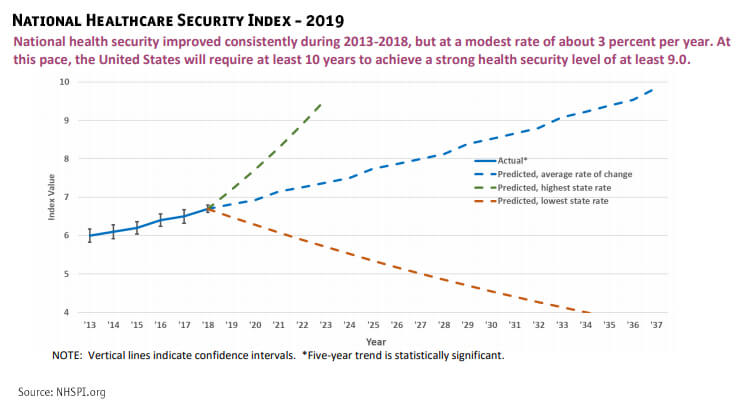US Ability to Manage Health Emergencies Rises. State Regional Inequities in Preparedness Persist.
The 2019 National Healthcare Security Index has been released. The scores indicate the ability to protect the health security of Americans from incidents like newly emerging infectious diseases, terrorism, and extreme weather conditions at the state and national levels. Healthcare emergency preparedness in the United States has improved significantly over the past six years according to a nationwide index of health security, though the last year saw relatively slow rates of progress as deep regional differences remain.
The United States scored a 6.7 on a 10-point scale for preparedness. That’s a 3.1 percent improvement over the last year, and a 11.7 percent improvement since the Index began in 2013.

The Index measures 6 groups of emergency preparedness activity:
1. Health Security Surveillance – monitor and detect health threats and to identify where hazards start and spread so that they can be contained rapidly.
2. Community Planning and Engagement – develop and maintain supportive relationships among government agencies, community organizations, and individual households; and to develop shared plans for responding to disasters and emergencies.
3. Information and Incident Management – deploy people, supplies, money, and information to the locations where they are most effective in protecting health and safety;
4. Healthcare Delivery – ensure access to high-quality medical services across the continuum of care during and after disasters and emergencies
5. Countermeasure Management – store and deploy medical and pharmaceutical products that prevent and treat the effects of hazardous substances and infectious diseases, including vaccines, prescription drugs, masks, gloves, and medical equipment
6. Environmental and Occupational Health – maintain the security and safety of water and food supplies, to test for hazards and contaminants in the environment, and to protect workers and emergency responders from health hazards while on the job.
Each state and the nation are evaluated with preparedness metrics—including the percentage of bridges that are in good condition, hazard plans in nursing homes, paramedics and medical volunteer availability, and other factors—to calculate a composite score providing a comprehensive picture of health security.
